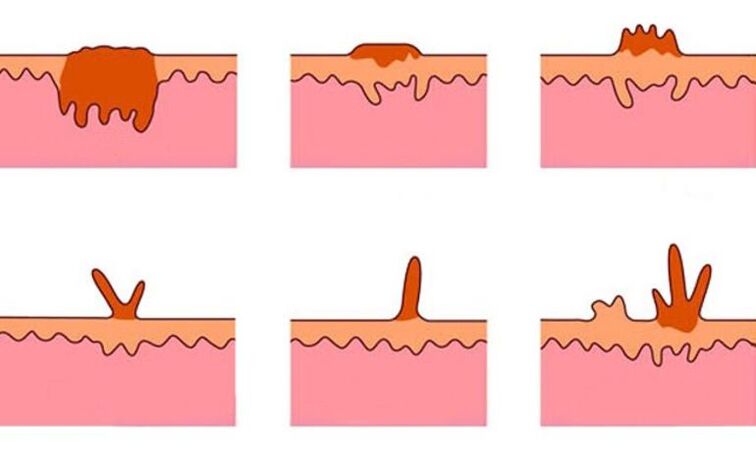
What is a papilloma?
Human papillomavirus includes more than 600 types of strains (cultures of certain types of microorganisms, originating from certain sources and having characteristic features), under the influence of which the formation of various categories of papillomas occurs. In medical practice, it is customary to divide types and types of papillomas depending on their origin, how they look, how quickly they grow and where they are localized. Certain papillomatous growths appear in the intraoral cavity, in the vagina, on the penis and in the bladder area.
Identification of papilloma classification is very necessary from the point of view of choosing the appropriate treatment method and analyzing the possibility of papilloma development into malignant neoplasia.
Papilloma is a benign skin tumor whose structure contains blood vessels and connective tissue covered with epithelium, which grows upwards and outwards.
Types of papillomas
There are several types of this formation. There are more than 100 types of papilloma, characterized by individual characteristics.
| Name | Description |
|---|---|
| Easy | Dense growth with a semicircular smooth surface. It usually occurs in the fingers, hands, and in rare cases in the knees. Similar formations appear in childhood and adolescence. Usually goes away on its own without leaving any consequences. |
| flat | A formation that has a round shape. They are easy to see visually because they rise above the skin. They often trigger the occurrence of various inflammatory processes, where people complain of itching and burning. Usually detected almost immediately after appearance |
| Plantar | Papilloma, which in the first stage of development people often confuse with calluses. After some time, the edges of the formation are formed, and the center of the papilloma can be distinguished. While walking, people notice severe discomfort, and sometimes pain develops. An alternative name for the papilloma is a thorn. |
| Filiform | Elongated growth, similar to several connected threads. Usually develops in old age. The most popular location areas: neck area, under the arms, near the eyes. Due to their awkward shape, they are characterized by a high risk of injury |
| Condyloma acuminata | Papilloma is located on the mucous membrane. They are characterized by the highest level of danger, because there is an increased risk of their violence. Immediate elimination of this formation is required. If such a growth is detected, you should immediately see a doctor. |

Based on external signs, certain papillomas can be assigned to certain groups. To accurately determine the type of papilloma and the cause of its appearance, it is necessary to conduct a comprehensive examination and the help of specialists.
Causes of papillomas
According to medical statistics, today almost 90% of people are carriers of the human papillomavirus, which is the main cause of papillomas. This viral disease exists in the body for a long time without showing any external symptoms. However, various internal infections and viruses, exacerbation of chronic diseases, abnormal nutrition and constant stressful situations suppress the immune system and trigger the formation of papilloma-like growths on the skin.
Among women
An increase in viral activity can occur due to various specific reasons. Papilloma often forms during pregnancy, because during pregnancy there is a sharp decrease in immunity and a deterioration in the body's condition. The acceleration of their growth is affected by the pathology in the production of hormones, which manifest themselves not only during pregnancy, but also as a result of the continuous use of contraceptives. Some scientists talk about a natural tendency for the formation of papillomas. Often this factor affects the occurrence of genital warts.

In men
When the virus enters the male body, its development in a person with strong immunity is suppressed. Therefore, the carrier of the disease may not be aware of the infection for a long time (from two weeks to several years). The main reason why papillomas appear on the body is the activation of inactive viruses.
Most papillomas occur in the mouth, larynx, and trachea.
Risk factors
- A sudden drop in immunity, weakening the whole body.
- Constant stress, nervous shock, prolonged depression.
- Smoking, frequent drinking of alcoholic beverages, and other bad habits.
- Infectious diseases, including ARVI, influenza.
- Gastrointestinal disorders.
- Active sex life.
- The use of certain drugs, especially antibiotics.
- Visiting public places characterized by high humidity: saunas, baths, swimming pools, beaches.
Papilloma location
The most common in the doctor's practice are filiform papilloma, vulgar or genital, as well as condyloma.
The location of filiform warts is the face, vulgar warts are more often located on the legs or hands, and condylomas are located exclusively on the mucous membrane (head of the penis and in the urethra in men, in the area of the labia minora and vagina in women), but it happens that any-These warts may appear in unusual places.
Removing such papillomas is not difficult in modern conditions, but the danger is the fact that with a decrease in immunity, new papillomas may reappear, which will lead to worse health consequences, for example, the next occurrence of condyloma is fraught with development. cervical cancer in women.
Plantar warts most often appear on the soles of the feet and rough balls of the toes. Sometimes a spine may appear on the thumb after serious damage to the skin in this area.
In general, papillomatosis is a common form of pathology in which neoplasms are formed throughout the human body. These growths have a characteristic appearance, so as soon as you see the manifestation of the disease, it can no longer be confused with other diseases.
danger
Papilloma is a benign neoplasm, but has a risk of malignancy. If the papilloma suddenly increases in size and causes concern, it is necessary to undergo tests to exclude malignant neoplasms. The most susceptible to degeneration is the papilloma that forms on the mucous membrane. Formations that are not treated for a long time are more susceptible to malignancy.
Areas of the body where papillomas are removed incorrectly have a high risk of degeneration into cancerous tumors.
- Degeneration of genital warts located in the vagina. There is a risk of cervical cancer. This process takes a long time, but the disease does not show itself with characteristic symptoms. If you do not undergo a preventive inspection, it is almost impossible to identify violations. Pathology appears only at the last stage.
- If the papilloma is damaged, there is a possibility of the infection spreading to the undamaged area. There is a risk of formation of growths located next to each other. If you see such a disorder, you need to pay attention to the increased activity of the virus and undergo symptomatic treatment.
Papilloma virus treatment:
- Antiviral and immunomodulatory therapy;
- Laser removal;
- Treatment of papilloma virus with nitrogen (cryodestruction);
- Radio wave treatment methods.
Prevention of papillomas
According to medical research, the prevalence of HPV among the population over the age of 50 is at least 75%. There are many situations in which the papilloma virus is transmitted. Prevention of infection becomes clear already at the stage of studying the route of papillomavirus transmission.
- You can not walk in public places with a high level of heat and humidity without shoes, because human papillomavirus can be on the surface of the floor covering, because plantar warts are highly contagious;
- you need to minimize the number of physical contacts with infected people, also avoid using their personal items;
- During intimate relations, condoms should be used (unfortunately, this method does not provide a 100% guarantee, but it significantly reduces the possibility of infection).
Prevention of papillomas at home should be aimed at following the rules of personal hygiene, airing shoes, disinfecting the bathroom after visiting it by other people.























